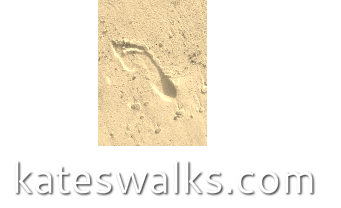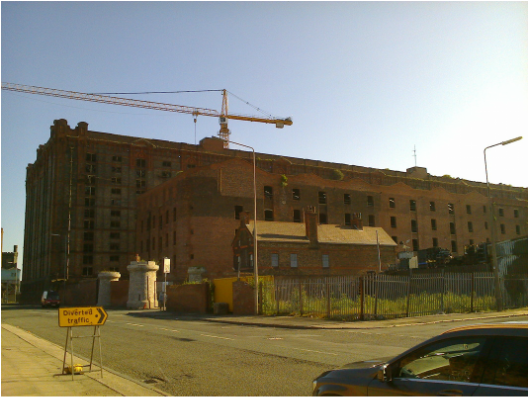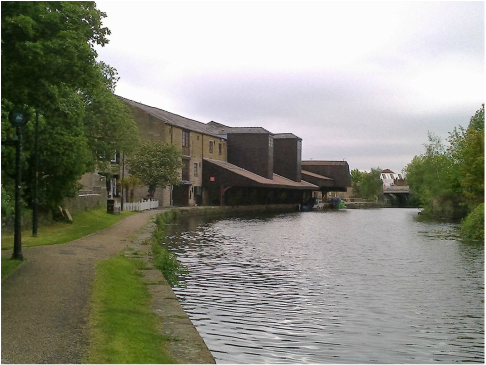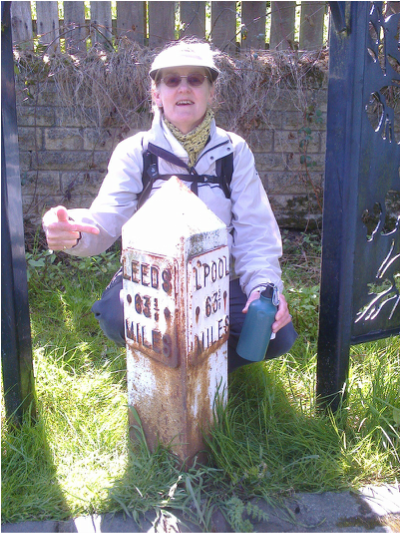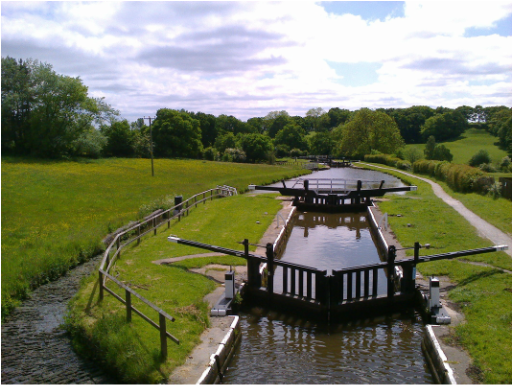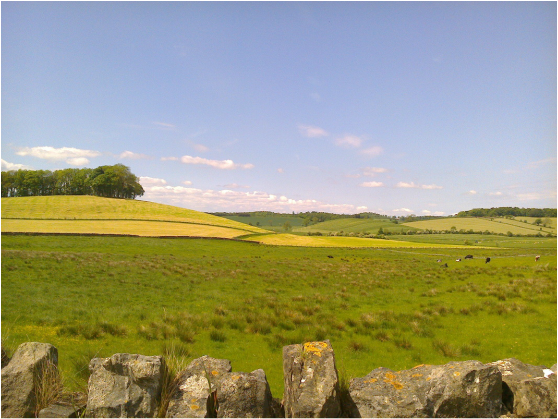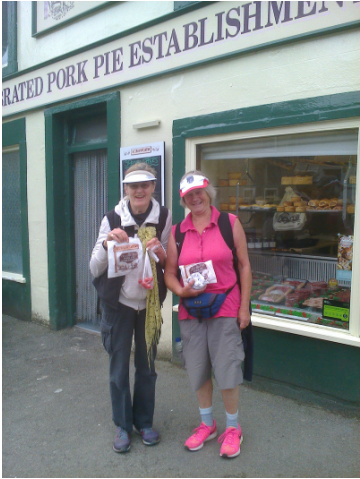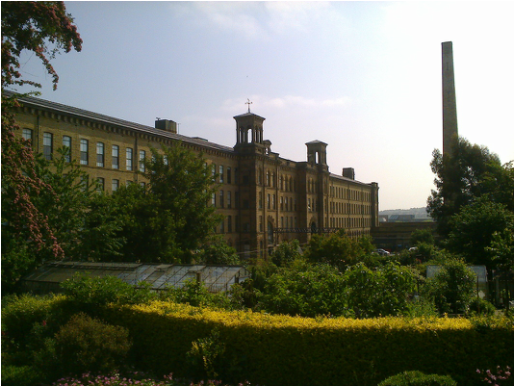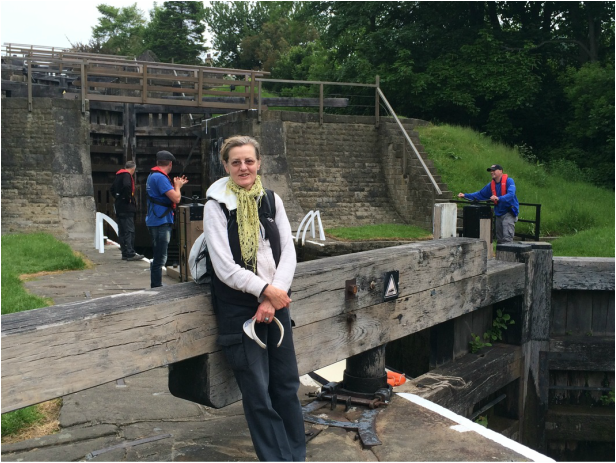Liverpool-Leeds Canal Post walk Blog 30th May to 5th June 2016
Raising money for Prospect burma www.justgiving/kateainsliewilliams
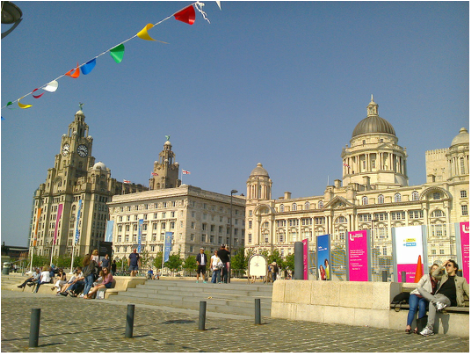
If any of you out there has an inclination for a long walk, the Liverpool/Leeds Canal is a 'must walk'! It has amazing industrial architecture and wonderfully warm, friendly people, but above all, some of the mostbreathtakingly beautiful countryside I have ever walked through.
I had low expectations of this walk. Not sure why. Venturing north into unknown territory perhaps?!
But how wrong could I be. Each day just got better
and better.
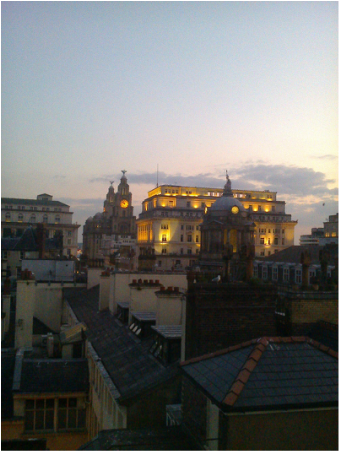
For a start, I fell in love with Liverpool. I opened the door to my
ZIP hotel 'box' and there outside the window over the rooftops
was the Liver Building with the Mersey beyond. How lucky was that!
I met a couple in the lift who didn't even have a window!
View from my hotel window
ZIP hotel 'box' and there outside the window over the rooftops
was the Liver Building with the Mersey beyond. How lucky was that!
I met a couple in the lift who didn't even have a window!
View from my hotel window
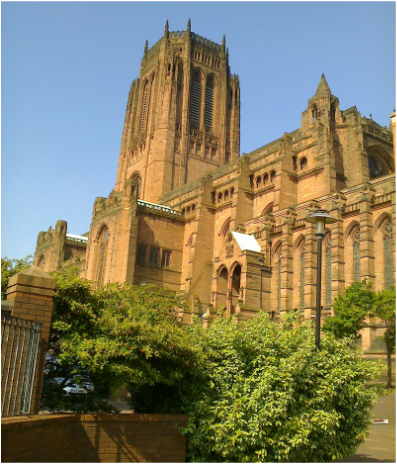
The city has more Georgian buildings than Bath. Really????? Well, I found them, rows upon rows of pretty red brick Georgian terraces up on the hill and civic buildings such as the town hall and the Assembly rooms, the latter dilapidated and neglected.
And as for those incredible cathedrals! I heard the bells of the Anglican Cathedral and thought I was close by. It is so huge it took me another 20 minutes to reach it! It is the largest in the UK and the longest in the world. It took 74 years to build with the Service of Thanksgiving taking place in October 1978. And to design it when you are only 22!
Giles Gilbert Scott was so young they gave him G.F.Bodley to hold his hand. Bodley died soon after and GGS redesigned the building and persuaded the Church Committee to run with it. Hence the single massive central tower instead of the twin towers of the original design. he also redesigned the Lady Chapel which is simply beautiful. I had just come out of there when the organ* struck up. There was a young man** playing and , blow me down, if he wasn't practising for a concert the next day. How lucky was that! I sat and listened to this amazing sound. I was entranced and it brought tears to my eyes.
*in 1926 largest musical instrument ever conceived with over 10,000 pipes! **the associate organist, Daniel Bishop
And as for those incredible cathedrals! I heard the bells of the Anglican Cathedral and thought I was close by. It is so huge it took me another 20 minutes to reach it! It is the largest in the UK and the longest in the world. It took 74 years to build with the Service of Thanksgiving taking place in October 1978. And to design it when you are only 22!
Giles Gilbert Scott was so young they gave him G.F.Bodley to hold his hand. Bodley died soon after and GGS redesigned the building and persuaded the Church Committee to run with it. Hence the single massive central tower instead of the twin towers of the original design. he also redesigned the Lady Chapel which is simply beautiful. I had just come out of there when the organ* struck up. There was a young man** playing and , blow me down, if he wasn't practising for a concert the next day. How lucky was that! I sat and listened to this amazing sound. I was entranced and it brought tears to my eyes.
*in 1926 largest musical instrument ever conceived with over 10,000 pipes! **the associate organist, Daniel Bishop
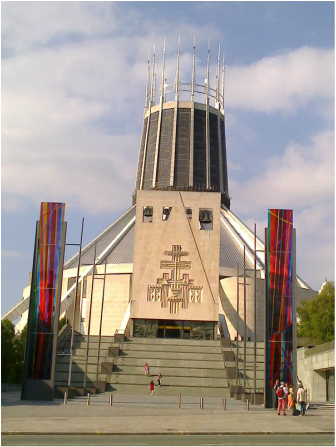
At the other end of Hope Street stands Frederick Gibberd's catholic cathedral. The two could not be more different, yet they stand in such close proximity. Gibberd's cathedral took five years to build, completing in 1967 and is one of the outstanding examples of '60s modernism. Sadly, there was no organ playing to accompany my visit. It is nicknamed 'Paddy's Wigwam' in recognition of Liverpool's Irish heritage. To me, it looks like some strange alien structure has landed from another world. The audacity of the design must have been shocking at the time. Unfortunately, I couldn't access Lutyens' crypt, the only part of his earlier grandiose design to be built.
Metropolitan Cathedral of Christ the King
Metropolitan Cathedral of Christ the King
Day 1 of the Walk
At 7.30 there was not a soul about and then I realised it was Bank Holiday Monday, not the Marie Celeste. I started at Albert Dock, the new terminus for the canal since 2009. Its praises are sung but I found it gloomy with all that red brick.
Walking past the Three Graces, one gets a real sense of the power of the place in its heyday. Also, a glimpse into its past: a memorial plaque to over a million Irish who left for America in the mid-1800s and a memorial to the 244 engine room staff who remained at their posts while the Titanic sank.
I waved good-bye to the Liver Birds, supposed to be cormorants holding sprigs of seaweed in their mouths. According to popular legend, the female is looking out to sea for handsome sailors returning and the male looking inwards to check the pubs are open!
I then had a rather amazing experience. I walked for two hours north through the docks area, alone apart from the occasional car and dog walker, passing acres of derelict land and dilapidated buildings with the odd warehouse converted to apartments, always with the Mersey in sight.
I walked past the Corn Warehouse, the Tobacco Dock and Warehouse*, the Tea Warehouse, the Rum Warehouse and various other nameless warehouses. And some of these were huge. I've never seen such enormous towering buildings, all in red brick with wonderful classical detailing. Real Victorian showy-off stuff. Again, it made me realise what a hugely powerful and important place Liverpool was in its prime. And I only walked about a third of this landscape. The docks stretch on for several miles more.
*built in 1901, world's largest brickwork building
Walking past the Three Graces, one gets a real sense of the power of the place in its heyday. Also, a glimpse into its past: a memorial plaque to over a million Irish who left for America in the mid-1800s and a memorial to the 244 engine room staff who remained at their posts while the Titanic sank.
I waved good-bye to the Liver Birds, supposed to be cormorants holding sprigs of seaweed in their mouths. According to popular legend, the female is looking out to sea for handsome sailors returning and the male looking inwards to check the pubs are open!
I then had a rather amazing experience. I walked for two hours north through the docks area, alone apart from the occasional car and dog walker, passing acres of derelict land and dilapidated buildings with the odd warehouse converted to apartments, always with the Mersey in sight.
I walked past the Corn Warehouse, the Tobacco Dock and Warehouse*, the Tea Warehouse, the Rum Warehouse and various other nameless warehouses. And some of these were huge. I've never seen such enormous towering buildings, all in red brick with wonderful classical detailing. Real Victorian showy-off stuff. Again, it made me realise what a hugely powerful and important place Liverpool was in its prime. And I only walked about a third of this landscape. The docks stretch on for several miles more.
*built in 1901, world's largest brickwork building
Tobacco Dock and Warehouse
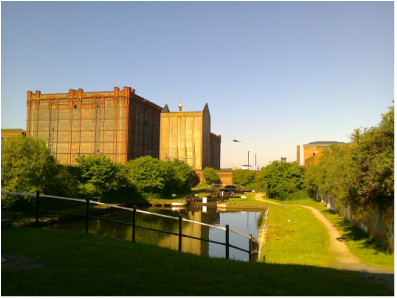
So when I finally came upon a small opening in a brick wall and stepped through into the diminutive world of the canal and its little locks and gates, I felt like Alice through the Looking Glass. All was peaceful, still and quiet in the sun, with a pair of Canada geese and their brood of 13 goslings gliding by.
Start of canal proper, with tea warehouse in background
Start of canal proper, with tea warehouse in background
West Lancashire Plain
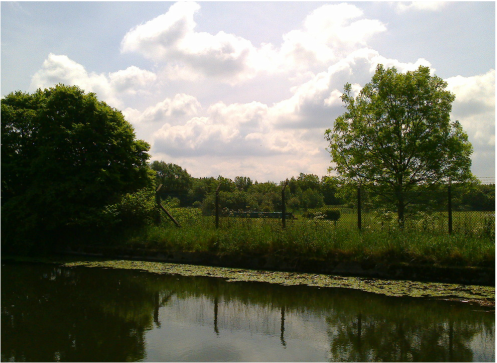
I hadn't done my research so I didn't know where I was now walking, except I knew I would be passing Aintree and Canal Turn. I had seen the canal while watching this year's Grand National! When I did get there it all looked rather forlorn with none of the paraphanalia of race day. The jump itself looked a doddle!
Believe it or not, this is the Canal Turn jump!
Believe it or not, this is the Canal Turn jump!
I then, like Alice, fell down a rabbit hole while reading somebody's dropped score card for ...... wait for it ....... foot golf at Aintree. Yes, apparently we now play golf with our feet. The inventiveness of the human species boggles the mind! And my ankle was jolly sore!
I walked for a day and a half across West Lancashire's coastal plain - flat as a pancake, arable, with crops or kale, beetroot, onions, you name it, growing in deep chocolate coloured soil, with not a stick of shade. It is, or was, hare coursing country. Well, it would be it's so damn flat. You could chase a hare for miles.
It was seriously hot but luckily this canal has not got rid of its pubs so I was able to dive into a pub every now and again for shade and liquid. There was also a cooling north easterly breeze. Otherwise, I think I would have seriously reached for my taxi number list!
My first night was spent at Oaklea Racing Stables, Lydiate, owned by Mandie and Paul Green. No, I didn't sleep in a stable. I did actually have a very comfortable bed in a converted barn and a delicious breakfast the next day to send me on my way.
I walked for a day and a half across West Lancashire's coastal plain - flat as a pancake, arable, with crops or kale, beetroot, onions, you name it, growing in deep chocolate coloured soil, with not a stick of shade. It is, or was, hare coursing country. Well, it would be it's so damn flat. You could chase a hare for miles.
It was seriously hot but luckily this canal has not got rid of its pubs so I was able to dive into a pub every now and again for shade and liquid. There was also a cooling north easterly breeze. Otherwise, I think I would have seriously reached for my taxi number list!
My first night was spent at Oaklea Racing Stables, Lydiate, owned by Mandie and Paul Green. No, I didn't sleep in a stable. I did actually have a very comfortable bed in a converted barn and a delicious breakfast the next day to send me on my way.
Scarisbrick hall
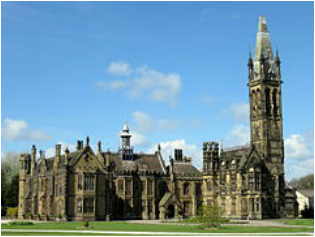
I was hoping to catch a glimpse of one of England's finest examples of Victorian Gothic architecture, remodelled by AWN Pugin, but it was screened out by trees, blissfully spreading their shade out over the canal. I did turn my head for a moment and caught a glimpse of Scaribrick's tower through the only gap.
Now, there's a story that makes the bit of my heart which is feminist sing out loud. Anne Scarisbrick fought her brother for her inheritance for five years to no avail and finally took over when he died. She was only left the building, not the contents, and had to redecorate which she did in style. She hired Pugin's son, EW Pugin, to do it. It was she who replaced the existing clock tower with the grander and taller 100' tower in French Gothic style that I was now looking at. She was a great socialite, entertained on a grand scale and finally died there at the age of 84 in 1872.
Now, there's a story that makes the bit of my heart which is feminist sing out loud. Anne Scarisbrick fought her brother for her inheritance for five years to no avail and finally took over when he died. She was only left the building, not the contents, and had to redecorate which she did in style. She hired Pugin's son, EW Pugin, to do it. It was she who replaced the existing clock tower with the grander and taller 100' tower in French Gothic style that I was now looking at. She was a great socialite, entertained on a grand scale and finally died there at the age of 84 in 1872.
Whoever walked to wigan?
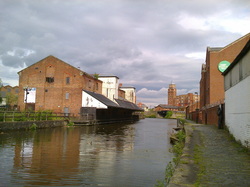
Well, I did on Day 2 and I was impressed with what I found, particularly with Boots who held the doors open for me at 5.30 as I bought safety pins to replace a broken zip on my windproof jerkin. Premier Inn took a bit of finding but it soon hove into sight in all its glorious shades of purple and white!
George Orwell's Wigan Pier is long gone. Even he wasn't sure where it was. Apparently, it was sold for scrap(£34) in 1929. In 1986 a re-creation was made by local students of Wigan and Leigh College.
Wigan Pier
George Orwell's Wigan Pier is long gone. Even he wasn't sure where it was. Apparently, it was sold for scrap(£34) in 1929. In 1986 a re-creation was made by local students of Wigan and Leigh College.
Wigan Pier
Day 3
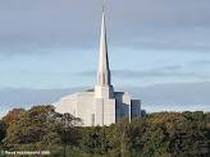
Today I walked into the hills. Wigan's 21 locks took me up to the high ground to the east of Wigan. It's a day's work to get a narrow boat through these locks! It took me about an hour to walk it. I was heading for Blackburn and soon had sight of the far-off South Pennines. The atmosphere was quite different up here - fresh and energetic. Almost thought I could be in the hills of Scotland.
The joy of this canal is that there are more often than not views to the surrounding countryside. Passing Chorley, south of Preston, I did see an extraordinary sight on the skyline. It looked like the upturned hull of an enormous ocean-going vessel, all white and angular, crowned by a tall elegant spire with something gold atop! It looked so alien it couldn't be British.
Of course, it was American - the north-west base of the Church of Latter Day Saints and its missionary training centre, opened in 1998. The 'something gold' was the angel who directed Joseph Smith to a butied book which became the Book of the Mormons! Apparently, the oldest surviving branch of the Church is in Preston, not US!
The joy of this canal is that there are more often than not views to the surrounding countryside. Passing Chorley, south of Preston, I did see an extraordinary sight on the skyline. It looked like the upturned hull of an enormous ocean-going vessel, all white and angular, crowned by a tall elegant spire with something gold atop! It looked so alien it couldn't be British.
Of course, it was American - the north-west base of the Church of Latter Day Saints and its missionary training centre, opened in 1998. The 'something gold' was the angel who directed Joseph Smith to a butied book which became the Book of the Mormons! Apparently, the oldest surviving branch of the Church is in Preston, not US!
Day 4 - 'industrial' day
At Blackburn, a flight of 6 locks raised the canal to 400' above sea level. More importantly, it gave views out over the town which has its fair share of cotton mills and lines of workers' cottages trailing up the hills. The cathedral was blanked out by a hideous modern building, with its tower just in sight.
Eanam Wharf, Blackburn - example of classic Victorian canal architecture
Next stop Clayton Le Moor. Its existence is owed to the canal and is the half way point. I thought it sounded very romantic, worthy of a Georgette Heyer novel and a great place to stop for lunch.
Oh dear, poor Clayton Le Moor, it was anything but. Every other house was for sale by auction and many shops were closed on a very busy road stretching through the middles. It was the only place on the whole walk that I saw any reference to the EU Referendum. A huge sign on the side of a building said, 'Vote Leave'! The Hare and Hound gave us a lovely welcome and a delicious lunch.
Of interest to me was John Mercer, a self-taught chemist, who lived here and invented the mercerisation of cotton. how many times have I used that word in my career and not realised it was somebody's name!
Oh dear, poor Clayton Le Moor, it was anything but. Every other house was for sale by auction and many shops were closed on a very busy road stretching through the middles. It was the only place on the whole walk that I saw any reference to the EU Referendum. A huge sign on the side of a building said, 'Vote Leave'! The Hare and Hound gave us a lovely welcome and a delicious lunch.
Of interest to me was John Mercer, a self-taught chemist, who lived here and invented the mercerisation of cotton. how many times have I used that word in my career and not realised it was somebody's name!
Half way point
My walkfriend on this day was Lesley Reynolds, my cousin. On regaining the canal, she was struck - and me for the umpteenth time - by the physical sensation of stepping from one world down into another - no longer people, noise, signage, cars, busy roads but peace and tranquility, with the canal, a constant companion, motionless except for the occasional rustle of the wind or a mother duck with her ducklings gliding by or the froth of gnats dancing on the surface, chased by the swallows.
Typical view of canal
The next 'B', Burnley, was a revelation. The canal passes over a 60' high embankment, known as the straight mile and built to avoid locks. It cuts through the town and over the River Brun*, giving great views to east and west and to the hills beyond.
In its heyday. Burnley was the world centre of cotton weaving and the world's largest producer of cotton cloths and consequently now has the best preserved 19th century industrial district in the country.
I felt very happy walking through Burnley. It seemed a positive and happy place** lying to either side of me in the sun surrounded by hills. Even an attack by a ferocious swan on the towpath didn't spoil it.
*Burnley/Brun Lea = meadow by the rive Brun
** I've since learnt it won the Enterprising Britain Award from the UK government in 2013. Perhaps I felt a bit of that energy!
In its heyday. Burnley was the world centre of cotton weaving and the world's largest producer of cotton cloths and consequently now has the best preserved 19th century industrial district in the country.
I felt very happy walking through Burnley. It seemed a positive and happy place** lying to either side of me in the sun surrounded by hills. Even an attack by a ferocious swan on the towpath didn't spoil it.
*Burnley/Brun Lea = meadow by the rive Brun
** I've since learnt it won the Enterprising Britain Award from the UK government in 2013. Perhaps I felt a bit of that energy!
Day 5
Friday was a special day. it not only was the day I went 'over the top' at 487ft above sea level, but also the day I walked through some of the most beautiful country I have ever walked.
The sun was shining, the sky was azure blue and the breeze was on my face. I had the company of curlews, peewits and swallows, sleepy cows ruminating in the heat of the sun and sheep bleating in the fields. I saw nothing man-made for several hours except the canal, a couple of narrow boats and bicyclists and far-off tractors picking up silage.
The sun was shining, the sky was azure blue and the breeze was on my face. I had the company of curlews, peewits and swallows, sleepy cows ruminating in the heat of the sun and sheep bleating in the fields. I saw nothing man-made for several hours except the canal, a couple of narrow boats and bicyclists and far-off tractors picking up silage.
It was truly magical and I longed for all my family and friends to be with me to experience it. I even cam across a little church, St Peter's Marton, sitting in the middle of a field with sheep grazing in the churchyard and surrounded by the grass covered humps of what had been an ancient hall. There was a big sign by the canal saying, 'I'm open every day'. Of course, I couldn't resist although my legs said, 'Oh no, not another detour'. It was charming and I bought a tea towel as a reminder.
On the ordnance survey map at Stanfords this area, between the Ribblesdale and the Airedale just south of the border of the Yorkshire Dales National Park, gives no hint of what a magical place it is, just a few hills marked. I have since learnt these are called drumlin hills, an Irish word referring to their shape - an elongated hill in the shape of an inverted spoon or half buried egg.
Reality soon hit. I met the Trans Pennine Trail and a clutch of bicyclists pushing and barging their way. I stood my ground and they grudgingly went round me.
I ended up in Gargrave, an enchantingly familiar place on the edge of the Yorkshire Dales, on a river, the Aire, with a church*, solid and traditional, a couple of pubs, one of which I was staying in, a war memorial, a bowling green, a cricket pitch, shops and a nearby station. Not a hint of an industrial building anywhere. I could have been back at home in the Cotswolds. It does have the A65 trundling through it sadly but luckily not past my bedroom window. I had the tractors pulling trailers of silage instead!!
*Iain Macleod, former conservative Chancellor of the Exchequer before his untimely death in 1970, is buried here.
Airedale - east of the pennines
I was now in wool cloth country, walking down Airedale through Skipton, Bingley, Keighley, Saltaire and a long slog into Leeds on a towpath crowded with Sunday walkers, bicyclists, dogs, prams and children.
Saturday(day 6) my walkfriend was Marion Arter, a school friend, and her husband, John, leap-frogging us in his car and buying us lunch in a pub! Skipton gave us delicious pies for our lunch and Bingley gave us one of the Seven Wonders of the Waterways* - a staircase of 5 locks raising the canal 60' over a distance of 320', an 18th centruy engineering masterpiece.
*Burnley embankment is another
Saturday(day 6) my walkfriend was Marion Arter, a school friend, and her husband, John, leap-frogging us in his car and buying us lunch in a pub! Skipton gave us delicious pies for our lunch and Bingley gave us one of the Seven Wonders of the Waterways* - a staircase of 5 locks raising the canal 60' over a distance of 320', an 18th centruy engineering masterpiece.
*Burnley embankment is another
Outside the pie shop in Skipton - with our pies!
Saltaire, on Sunday, gave me a delicious breakfast in Salts Diner, with PK who joined for the last day and our niece, Annie, and her boyfriend, Michael, who joined us for breakfast. We spent a couple of hours wandering around, full of admiration for Titus Salt's paternalistic vision for his enormously successful township of worsted cloth production and its thousands of textile workers on the River Aire and latterly, Jonathan Silver's vision for mill regeneration in a very successful mix of business and culture*.
*including David Hockney collection of paintings
*including David Hockney collection of paintings
Saltaire Mill
Finally ......
People are so friendly up here. I had chats with boat owners, dog walkers, fisherfolk and an American from Alabama biking round the UK. I was sung to by and Elvis Presley impersonator, covered in bling, with the biggest watch I'd ever seen, o bottom teeth except a couple of stubs, whose Italian uncle had an ice-cream van in Hammersmith. He was also a stand-up comedian and told me a joke about the Chinaman who ran a karaoke school in an ex-estate agent's, leaving the shop board up which said 'Housing' (How sing)! Luckily, he was biking the other way!!
I discovered I was walking the Liverpool/Leeds Canal on the 200th anniversary of its completion in 1816. How appropriate was that!
It is the longest canal in Britain built as a single waterway, with 91 locks. It lasted longer than the other two trans-Pennine canals and was still being used commercially well into the 1960s. The scale of the navigation, with locks built 62' long by 14' wide, allowed big payloads to be carried on broad boats which competed well with the railways. its raison d'etre was the Bradford merchants wanting to get their textiles to Liverpool and needing limestone in return and likewise, Liverpool wanted Yorkshire's supply of coal, the most important cargo on the canal.
It follows the contours of the land. I found myself wandering through a landscape of hills and mills in great loops, doubling back on myself and seeing features I thought I'd left behind reappearing. It is funny as I get no sense of direction on a canal unless I study my shadow or hold a compass.
But does it matter? No, as long as I reach my destination with a comfy bed, a hot shower and a good meal, I am happy.
I discovered I was walking the Liverpool/Leeds Canal on the 200th anniversary of its completion in 1816. How appropriate was that!
It is the longest canal in Britain built as a single waterway, with 91 locks. It lasted longer than the other two trans-Pennine canals and was still being used commercially well into the 1960s. The scale of the navigation, with locks built 62' long by 14' wide, allowed big payloads to be carried on broad boats which competed well with the railways. its raison d'etre was the Bradford merchants wanting to get their textiles to Liverpool and needing limestone in return and likewise, Liverpool wanted Yorkshire's supply of coal, the most important cargo on the canal.
It follows the contours of the land. I found myself wandering through a landscape of hills and mills in great loops, doubling back on myself and seeing features I thought I'd left behind reappearing. It is funny as I get no sense of direction on a canal unless I study my shadow or hold a compass.
But does it matter? No, as long as I reach my destination with a comfy bed, a hot shower and a good meal, I am happy.
